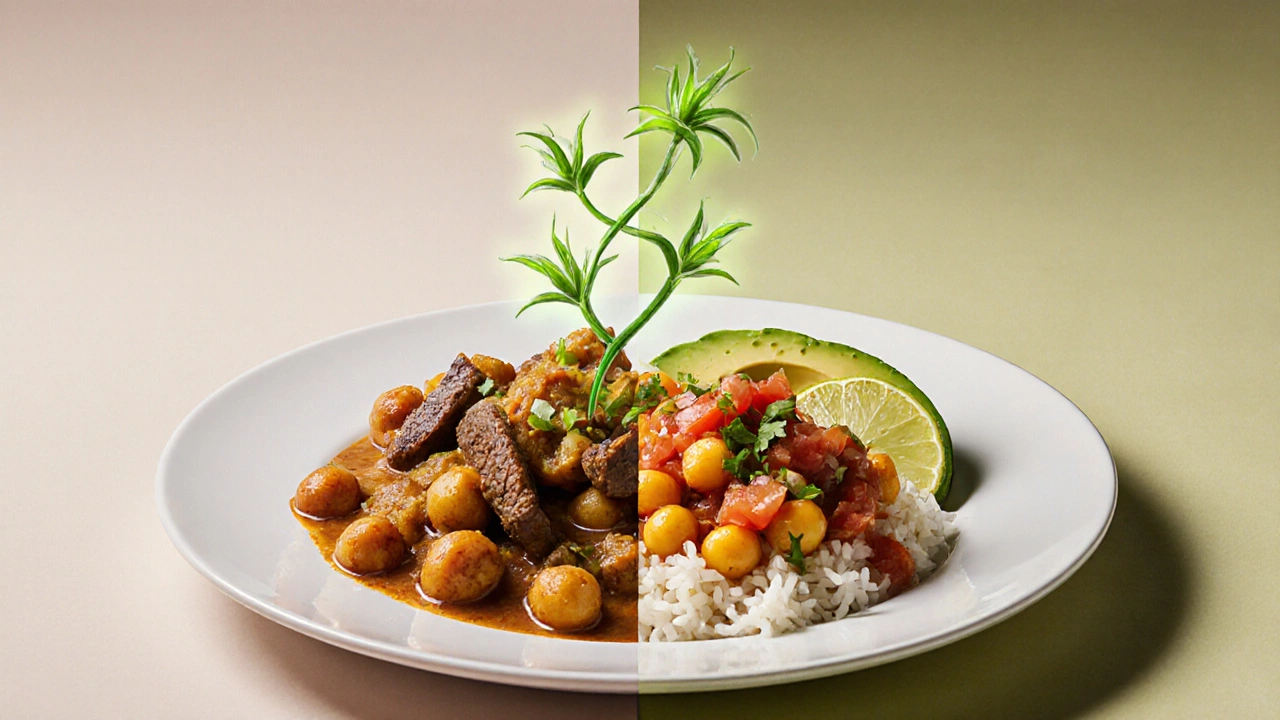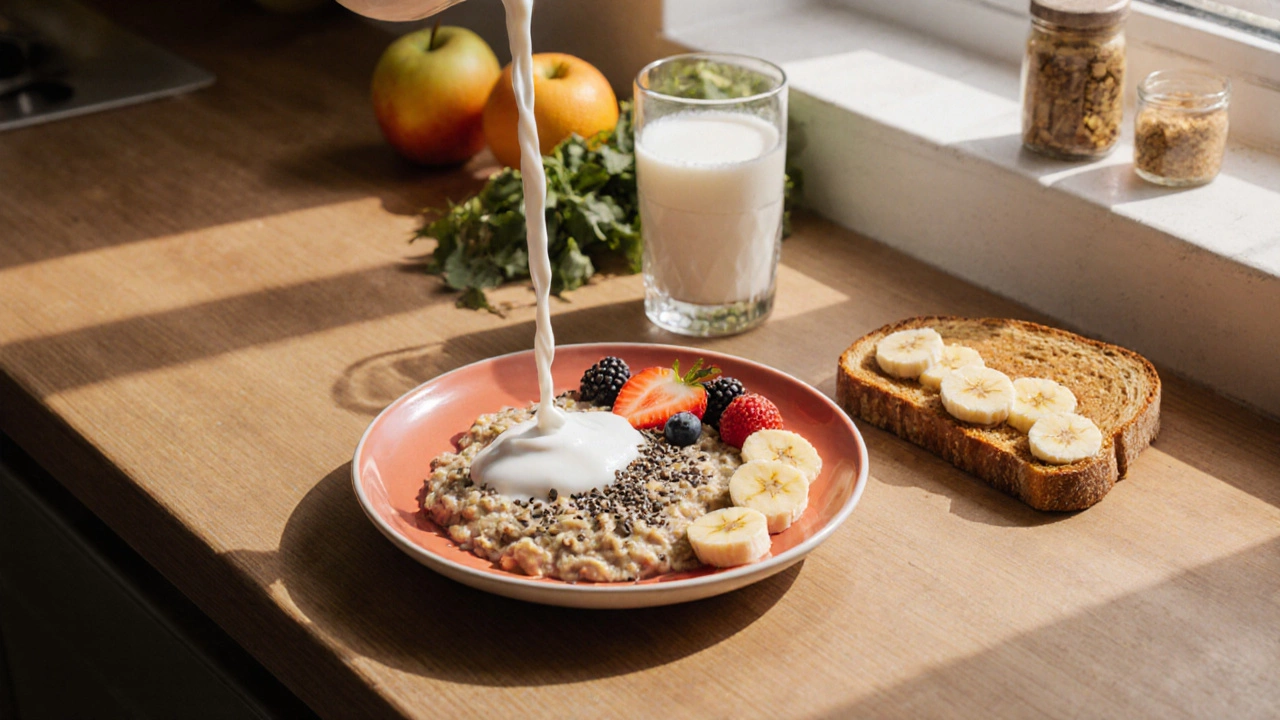Vegan Swap Finder
Find Your Perfect Plant-Based Swap
Replace animal products one simple swap at a time. No perfection needed!
If you’ve ever wondered what being vegan actually means-beyond just avoiding cheese-it’s time to cut through the noise. Being vegan isn’t about perfection. It’s not about buying expensive superfoods or spending hours in the kitchen. For beginners, it’s simply about choosing plants over animals in your meals. And yes, it’s easier than you think.
What Does Vegan Really Mean?
A vegan diet excludes all animal products: meat, fish, dairy, eggs, honey, and even ingredients like whey or gelatin. It’s not just a food choice-it’s a lifestyle that avoids animal exploitation in clothing, cosmetics, and more. But if you’re starting out, focus on the plate first. That’s where the real change happens.
Think of it this way: if you eat oatmeal with almond milk and banana for breakfast, you’re already halfway there. No need to overhaul your whole life on day one. Start with meals you already like, and swap out the animal stuff.
What Do Vegans Actually Eat?
People assume vegan means salads and tofu all day. That’s not true. Vegans eat everything from tacos to ice cream-just made without animals.
- Grains: Rice, quinoa, oats, barley, bread (check labels for dairy or honey)
- Legumes: Lentils, chickpeas, black beans, edamame-packed with protein and fiber
- Veggies: Broccoli, spinach, sweet potatoes, bell peppers, mushrooms-eat them raw, roasted, or in stews
- Fruits: Bananas, berries, apples, oranges-simple, natural, and sweet
- Nuts and Seeds: Almonds, cashews, chia, flax, sunflower seeds-great for snacks and creamy sauces
- Plant-Based Milks: Soy, oat, almond, pea milk-choose unsweetened if you’re watching sugar
- Vegan Alternatives: Plant-based burgers, cheese, yogurt, and even ice cream are widely available now
Most grocery stores in the UK now have a dedicated vegan aisle. In Manchester, chains like Tesco, Sainsbury’s, and Aldi stock over 50 vegan products each. You don’t need to shop at a specialty store to eat well.
Common Myths About Veganism
Let’s clear up a few misunderstandings right away.
- Myth: Vegans don’t get enough protein. Truth: Lentils, beans, tofu, tempeh, seitan, and even spinach have protein. You’d have to try hard not to get enough if you eat a variety of whole foods.
- Myth: Vegan food is bland. Truth: Spice blends like cumin, smoked paprika, turmeric, and nutritional yeast add deep, rich flavor. A pinch of salt and a squeeze of lemon can turn a plain bean bowl into something unforgettable.
- Myth: It’s expensive. Truth: Rice, beans, potatoes, and seasonal veggies cost less than meat and dairy. A bag of dried lentils costs under £1.50 and makes six meals.
- Myth: You have to cook all your meals. Truth: Canned beans, frozen veggies, pre-chopped salads, and ready-made vegan meals (like those from Linda McCartney or Beyond Meat) make it easy.

How to Start as a Beginner
You don’t need to go 100% vegan overnight. Here’s how to ease in without stress:
- Try Meatless Mondays. Pick one day a week to eat entirely plant-based. Notice how you feel afterward.
- Swap one thing at a time. Replace cow’s milk with oat milk in your coffee. Swap chicken in your stir-fry for tofu or chickpeas.
- Keep snacks handy. Hummus with carrot sticks, trail mix with nuts and dried fruit, or a banana with peanut butter are easy wins.
- Use apps or labels. Apps like HappyCow help you find vegan-friendly cafes near you. Look for the Vegan Society sunflower logo on packaging-it’s a trusted UK symbol.
- Don’t stress about mistakes. If you accidentally eat something with dairy, just move on. No guilt. Progress, not perfection.
Simple Vegan Meals to Try This Week
Here are three no-fail meals that take less than 20 minutes and use ingredients you probably already have:
1. Chickpea Curry
Heat a spoon of oil in a pan. Add a chopped onion, a crushed garlic clove, and a teaspoon of curry powder. Stir for a minute. Add one can of chickpeas (drained), one can of diced tomatoes, and a splash of coconut milk. Simmer for 10 minutes. Serve over rice. Done.
2. Bean Tacos
Warm corn tortillas. Mash a can of black beans with a pinch of cumin and lime juice. Top with shredded lettuce, sliced avocado, and salsa. Add hot sauce if you like it spicy. No meat needed.
3. Peanut Butter Banana Toast
Whole grain toast, thick spread of natural peanut butter, sliced banana, and a sprinkle of chia seeds. Eat it with a glass of oat milk. It’s breakfast, snack, or even dessert.
What About Nutrients?
You don’t need supplements to be healthy on a vegan diet-but a few things are worth paying attention to.
- Vitamin B12: Found naturally only in animal products. Vegans need a supplement or fortified foods (like plant milks or nutritional yeast). Take 2.4 mcg daily or 1000 mcg twice a week.
- Vitamin D: Especially important in the UK where sunlight is limited. A 10mcg daily supplement is recommended for everyone in winter.
- Iron: Found in lentils, spinach, tofu, and fortified cereals. Eat with vitamin C (like orange juice or bell peppers) to help absorption.
- Calcium: Fortified plant milks, tahini, almonds, and kale have plenty. A cup of fortified soy milk gives you about the same as cow’s milk.
Most people get enough of everything by eating whole, varied foods. Don’t overcomplicate it. Just focus on colorful plates and a daily B12 supplement.

What to Avoid When Starting Out
Here are common missteps that make veganism harder than it needs to be:
- Replacing meat with processed vegan junk. Vegan sausages and cheeses are fine occasionally, but they’re not health food. Stick to whole foods most of the time.
- Trying to replicate every meat dish. You don’t need vegan chicken nuggets to be happy. Embrace the flavors of plants-they’re different, but just as satisfying.
- Comparing yourself to others. Some vegans eat only raw food. Others eat vegan pizza every Friday. Both are valid. Find what works for you.
- Going too fast. If you quit after a week because you miss cheese, that’s okay. Try again next month. It’s a journey, not a test.
Where to Find Support
You don’t have to do this alone. There are tons of free resources:
- YouTube channels: Hot for Food, Pick Up Limes, and Plant Based on a Budget have simple, real-food recipes.
- Instagram: Search #VeganBeginner or #VeganManchester for local inspiration.
- Books: How Not to Die by Dr. Michael Greger or The Vegan Starter Kit by Dr. Neal Barnard are easy reads with science-backed advice.
- Local groups: Manchester has vegan meetups at the Vegan Society’s Manchester hub and regular potlucks at community centres.
Start small. Eat what you like. Learn as you go. You’re not trying to become a nutritionist-you’re just choosing plants over animals. And that’s enough.
Can I still eat out as a vegan beginner?
Yes, absolutely. Most restaurants now have vegan options-even pubs and cafes. Look for dishes with beans, lentils, grains, and veggies. Ask for no cheese or butter. Many places will adjust meals if you ask. Chains like Pret, Greggs, and Nando’s have reliable vegan items. In Manchester, places like The Vegan Kind and The Greenhouse offer full vegan menus.
Do I need to buy special vegan products?
No. You can eat a healthy vegan diet with just rice, beans, lentils, potatoes, vegetables, fruits, nuts, and seeds-all basic, inexpensive staples. Vegan cheese, meat substitutes, and snacks are optional. They’re convenient, but not necessary. Focus on whole foods first.
Is vegan food more expensive?
Not at all. A bag of dried lentils costs less than £1.50 and makes 6 meals. A kilo of rice is under £1.50. Tinned tomatoes, onions, and carrots are cheap too. Meat and dairy are often the most expensive parts of a shopping basket. Cutting them out usually saves money.
What if I miss cheese or eggs?
It’s normal. Try vegan cheeses made from cashews or coconut oil-they’ve improved a lot. For eggs, try scrambled tofu with turmeric and nutritional yeast-it looks and tastes surprisingly similar. Give it a few weeks. Your taste buds adjust, and you’ll find new favorites.
Will I lose weight going vegan?
Some people do, but weight loss isn’t guaranteed. It depends on what you eat. If you swap steak for vegan pizza and cookies, you won’t lose weight. But if you eat more whole plants-veggies, beans, fruits, grains-you’ll naturally eat fewer calories and feel fuller. Focus on health, not the scale.
Next Steps
Start tomorrow. Pick one meal-breakfast, lunch, or dinner-and make it vegan. Keep it simple. No need to plan a week’s menu. Just one change. That’s how habits form.
Keep a note on your phone: What I ate today. Write down what you had. After a week, look back. You’ll be surprised how easy it was.
Being vegan isn’t about being pure. It’s about choosing kindness, one plate at a time. And you’re already on the way.

